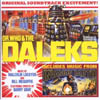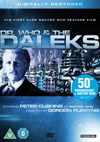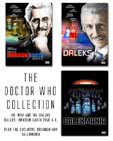DVD Extras include:
Blu-ray Extras include:
Well, I suppose it made good sense to capitalize on the Dalek-mania that swept through Britain with big feature films. Trouble is, this first one isn't that big. So much of the good, meaty dialogue of the TV version is missing, and it just doesn't manage to create the same creepy atmosphere for Skaro as its low-budget black and white television counterpart.
Unfortunately, Ian's role was reduced a little too much, until he was not much more than a bumbling buffoon, although Roy Castle could at least put his "Carry On...." comedic talents to use in keeping his portrayal somewhat interesting. Barbara has also lost much of her charm, notably her sharp wit, although Jennie Linden does all right with the mediocre role. Susan gets the best improvements of all - she no longer drags herself desperately through the adventure, but applies her intelligence and masters her fears. No wonder they brought Roberta Tovey back for the sequel. The TARDIS is introduced quite well, but like the other characters, she isn't quite herself either, and the interior room and lack of a proper dematerialization sound are both disappointments. For some strange reason, this film and its sequel are both reluctant to show the police box coming and going from the outside, apart from a single introductory dematerialization.
A most notable disappointment on Skaro is the lack of a decent model of the Dalek city. The television version had a great model, and the audience was given a beautiful panoramic view of it, not to mention an atmospheric `flight' towards it as though shot from an approaching anti-grav vehicle. In the feature film though, we only get a blurred view of it through some gnarly old trees, and we have to look up to it, and we only see a short piece of it from fairly close, instead of a cool view of the whole thing. The big screen has not begun to scratch the surface of what it could be doing to improve on the TV story. The Daleks are colourful. Yes. Actually, the inclusion of a red Dalek is good - indicating a rank between regular blue/grey Dalek and Supreme Black Dalek. In this regard, the feature films probably went a long way to introducing the idea of the Daleks using colour to display their rank. The speaking lights are bigger, which is better in this case; they no longer look like the last-minute additions that they were in the television versions. However, the reason for them being added at the last minute seems to have been forgotten. Instead of only having them flash when a Dalek speaks, to indicate which Dalek is speaking, someone with authority over the production now has to have them FLASHING ALL THE TIME! The uncredited vocal artists voicing the Daleks now have to put excruciatingly unnatural pauses in between every syllable to match up with-the-slow-but-stea-dy-bloo-dy-flash-ing! The Thal portrayals are also much blander than their television counterparts, although Alydon is still generally okay. Temmosus has pretty much lost his own screen-presence altogether. The swamp also appears to be much poorer done, in set design and in directorial execution - the creepy atmosphere is once again missing. The totally different style of sound and music is also largely responsible. The use of a gaseous foam spray for a Dalek's main weapon is an improvement over the dodgy TV negative effect, although its greater appropriateness will be more obvious in later stories, when the Daleks' battlecry of "Exterminate!" becomes more common. Although the film cannot match the TV series for atmosphere or dramatic tension, it does improve on the action sequences - not too difficult since most of these were bumbled in the TV version. Shots of the underside of the lift are still unnaturally inverted however. The Doctor has much more to do towards the conclusion of the film, and his final story beats are made more purposeful and heroic in the end. Ian also finally rises above his bumbling to make important contributions as well. A nice one-two hero/sidekick finish for the Doctor and Ian, although which of them is which is still too uncertain.
Meanwhile, the television show continued to explore its variety and flexible format.....
This story has become available on DVD and VHS video, and is also on Blu-ray for Region 2 only. Click on the Amazon symbol for the location nearest you for pricing and availability:
Comments on this article are welcome. You may contact the author from this page:
|
|||||||||||||||||||||||||||||||||||||||||||||||||||||
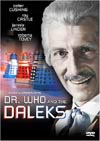
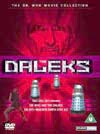
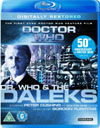


 A
A
